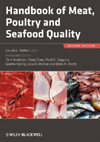At home, poultry holds the honor of being the most consumed protein, driven by chicken. Weekly consumption of chicken clenches 88 percent penetration, according to Chicago-based Mintel International’s Poultry U.S. report published in November 2017. At foodservice, 30 percent of consumers eat chicken at fast-food restaurants at least once a week, up from 22 percent in 2015, according to Chicago-based Technomic’s 2017 Poultry Consumer Trend Report. In addition, 24 percent of 18- to 34-year-olds order chicken from fast-food burger restaurants more often now than two years ago.
Overall, the meat department is still struggling with deflation, and as a result dollars remain flat, reports Chicago-based Nielsen FreshFacts for the total U.S. during the latest 52 weeks ending September 30, 2017. Chicken is up 2 percent in dollars, yet flat from a volume standpoint driven by sluggish chicken breast volume, says Sarah Schmansky, Nielsen Perishables Group’s director. Chicken thighs, wings, ground chicken and value-added varieties kept performance to minimal declines though, she says.
Table of Contents
With a continued growing economy and employment environment, demand for chicken and competing meats will most likely see 2018 build on the success experienced in 2017, says Tom Super, senior vice president of communications for the National Chicken Council (NCC), Washington, D.C.
“One of the biggest opportunities to grow is increasing access to foreign markets, such as China, Indonesia, India and Africa,” he says.
In addition, favorable feed costs resulting from abundant corn and soybean crops in 2017 will provide an incentive to increase production of chicken and competing meats beyond U.S. Departments of Agriculture’s current forecasts for 2018, Super says.
While turkey is down in dollars, it is flat in volume, Nielsen FreshFacts reports. The price drop for ground turkey helped volume sales in this sub-category to increase almost 3 percent, Schmansky says. Turkey wings and value-added varieties also showed signs of dollar and volume growth during the latest 52 weeks ending September 30, 2017.
In addition, with more than a 3 percent drop in average retail price, beef continues to show strong volume growth and have an impact on the overall performance of pork, turkey and chicken, Schmansky says.
“The 2017 market was pretty similar to what we saw on the latter part of 2016, which is to say not as favorable market as we would like,” says Joel Brandenberger, president of the National Turkey Federation (NTF), in Washington, D.C. “We believe that there are some fundamentals in place that will, through 2018, start to strengthen the market.”
NTF is working with industry partners to return turkey export levels back to their 2015 high, which was before the Highly Pathogenic Avian Influenza outbreak, and open up new international markets. In addition, NTF is focusing on growing institutional customers, such as schools and military hospitals.
NTF also has been working diligently for the past three years to create awareness of turkey by “influencing the influencers.”
“Now we feel like we can take what we’ve done in the last three years and look at areas where we can devote some additional resources and hopefully create a stronger environment for our members to go out and push their product lines in growing demand even further,” Brandenberger says.
Opportunities for growth
Since 2015, Mintel reports the poultry category has recorded relatively flat growth at retail because of lower pricing of poultry and other proteins. The good news is that Mintel anticipates poultry prices rebounding during the next five years bolstering category gains. In addition, the poultry category is well-positioned for growth with its favorable healthful reputation, the research firm says.
On the other hand, consumer concerns about processed foods in general have contributed to processed poultry products experiencing a 3 percent decline from 2016 to 2017, Mintel says. In turn, consumers are choosing foods they consider fresher and healthier, which is reflected in the fact that more than half of consumers believe poultry is healthier than other types of animal proteins, the research firm finds. Subsequently, nearly half (49 percent) of consumers say they have made such a switch to poultry in place of red meat to eat healthier.
Price also remains a factor with 22 percent of consumers substituting poultry for red meat to save money. More than half (54 percent) also believe poultry is more affordable than other types of animal proteins, Mintel reports.
Poultry also enjoys a solid reputation for taste, versatility and ease of use, which contributes to the high consumption of the category. Compared to other animal proteins, 46 percent of consumers say poultry has a greater variety of uses, 40 percent say poultry is more versatile to use in recipes, and 39 percent say poultry is easier to cook, Mintel reports.
Increasing consumption and purchase of poultry is not without its challenges in such a mature and popular market. Product development and recipe suggestions that incorporate chicken and turkey into nontraditional dayparts, such as breakfast and snacking, could help, Mintel suggests. Prepared options may be another way consumers can add poultry into their meals and snacks in new ways and more frequently. Nearly three-quarters of poultry launches in 2017 had claims such as convenient packaging or microwavable, growing 75 percent from 2014, Mintel reports.
In foodservice, chicken was on 95 percent of all restaurant menus and turkey was on 44 percent in 2017, according to MenuTrends, Chicago-based Datassential’s menu database that tracks the prevalence of ingredients on U.S. restaurant menus.
“Menu penetration — the percentage of restaurants that menu an ingredient — is down slightly for both proteins, as well as for [beef and pork],” says Kyle Chamberlin, project manager of Datassential’s Keynote Report: Meat & Poultry, December 2017.
A couple of bright spots for poultry exist on menus, however. Chicken is growing as a pizza topping, such as buffalo chicken pizza, and turkey is growing on appetizer and side menus thanks to sides of turkey bacon and sausage along with bowls of turkey chili. Duck also is growing on appetizer menus, with offerings including duck fat fries, duck meat in soups and on nachos and duck wings at upscale restaurants, Datassential reports.
In foodservice, two other bright spots for chicken have been breakfast and snacking occasions, where Technomic has reported growth since 2015. For example, 14 percent of consumers eat chicken for breakfast at least once a week, up from 9 percent in 2015. Additionally, 20 percent of consumers eat chicken as a snack at least once a week, up from 16 percent in 2015.
“Both of these occasions are widely acknowledged as growth opportunities in foodservice, so it is good to see that chicken is expanding beyond lunch and dinner and being able to capitalize on the opportunities there,” says Charles Winship, a senior research analyst of consumer insights for Technomic, a Winsight Co.
With meat snacks growing in foodservice and retail, Super agrees chicken has an opportunity to expand its market share in this category.
“Premium meat snacks are gaining the most consumer attention, but chicken has the ability to span the category from budget to gourmet,” he says. “Artisan meat snacks combined with quality nuts, seeds and dried fruits appear to be another opportunity for chicken. With the great ability to customize these types of products there will continue to be a proliferation of meat snacks, jerky and savory handhelds. Creative chicken marketers are poised to gain sales in this category.”
As turkey is consumed less often than chicken, beef and pork at foodservice, but is widely seen as a healthier option over those three, Technomic’s Winship believes this is something that can help provide an avenue for growth for turkey.
“The main thing we see with turkey consumption is that most people eat it,” he says. “It’s just not their usual diet.”
For example, close to two-fifths of consumers say they eat it only during the holidays or Thanksgiving and Christmas, Winship says. Despite that, a trend that bodes well for turkey is the growing number of Americans who visit full-service restaurants for holiday occasions, he adds.
Duck also is showing some growth, but mainly at smaller, emerging chains or high-end restaurants.
Healthy halo
As consumers’ interest in foods they can feel good about eating grows, free-from claims continue to increase. For example, launches of poultry with hormone-free claims grew by 67 percent from 2014 to 2017, Mintel reports. Launches of poultry with all-natural claims increased by 74 percent from 2014 to 2017, the research firm finds. Growing brands such as Just Bare, Hip Chick Farms, FreeBird and Applegate also use claims including no artificial ingredients and no antibiotics to communicate natural positioning. These brands also use free-from with ethical treatment claims to appeal to consumers driven by making responsible food choices, Mintel says.
While still filling a small niche in the market, production claims such as organic, antibiotic-free, hormone-free, vegetarian-fed and grass-fed are driving growth across all fresh meat, Schmansky says.
“Fresh meat without any claim saw marginal or declining performance, whereas fresh meat products with product claims saw double-digit growth in 2017,” she says.
In addition, new organic fresh meat items are up more than 20 percent versus a year ago. Nielsen FreshFacts also finds that sustainability is a motivator with 35 percent of consumers willing to pay more for locally sourced meat and 31 percent willing to pay more for ethically raised meat.
In an effort to respond to heightened consumer interest in animal welfare and more transparent discussion with all demographic groups’ concerns, NCC launched Chicken Check In, which provides answers to questions about U.S. chicken production and gives a look at the lives of the birds and how they get to tables.
“We take pride in the care of our chickens, but we know it’s on us as an industry to do a better job of providing more information on how our food gets from farm to table,” Super says. “Food is an emotionally charged topic, and with conflicting information readily available online and on social media, it’s understandable people are concerned. We invite consumers with open arms to come and take a look at the work we’re doing to progress as an industry in providing safe, healthy and sustainable food.”
At foodservice, trends around health and animal welfare also benefit poultry. According to Winship, Technomic’s data shows consumers ordering healthy options from foodservice on a more frequent basis.
“[Chicken and turkey] are two very reliable proteins for consumers who are looking to eat healthy with animal welfare factoring in as that new component of health,” he says. “It’s been easier for a lot of chains to make animal-welfare commitments with their chicken products instead of beef. … It’s something (that’s) going to bring chicken into the spotlight for good reason.”
Datassential agrees clean labels are growing on menus. Although antibiotic-free and hormone-free are mentioned on less than 1 percent of chicken dishes in restaurants, both terms have seen major growth over the past four years.
“We expect these clean-label terms to continue to grow in poultry products at retail and poultry dishes in restaurants,” Chamberlin says.
Time and money
Consumers’ busy lifestyles are driving development of poultry products that promise ease of preparation, faster cooking time and versatility. In turn, almost three-quarters of poultry launches last year had claims such as convenient packaging or microwavable, jumping 75 percent from 2014.
In regard to convenience, new poultry burger and patty options in the grocery stores have increased 12 percent from 2014 to 2017, Mintel finds. Brands are looking at the variety and flavors of poultry burgers sold in restaurants for inspiration. Alternative-base burgers are growing on menus too, with menu incidence of chicken and turkey burgers up 8 percent and 3 percent from the second quarter of 2016 to 2017, respectively, Mintel reports.
Poultry companies continue to develop products aiming to take some of the effort out of meal preparation for everyday and special occasions through value-added products as well, Mintel says. For example, individually wrapped or resealable packaging for poultry products allows consumers to pick portion sizes.
Schmansky agrees advancing value-added options is one area the poultry industry could focus for growth. Fully cooked and value-added meat products, while just 6.5 percent of total meat, showed signs of growth: up 1.5 percent in dollars and 3.5 percent in volume, she says.
Continued pricing pressures, reduced trips and spending and competition from plant-based proteins are all challenges the poultry market will face at retail, she adds.
Flavors favored
With more challenges at retail and foodservice, seasoned/flavored poultry products have become a key driver to influence consumers to spend more money on convenient and value-added products, Mintel reports. Mintel Purchase Intelligence finds that average purchase intent for seasoned/flavored poultry products is greater than it is for unseasoned/unflavored poultry. In addition, seasoned/flavored poultry products score higher on average than unseasoned/unflavored poultry on attributes such as convenient, tasty, exciting, fun, great value, indulgent treat and premium, according to the research firm. Hispanic and Asian populations also are growing, and manufacturers can cater to those growing demographic needs.
“They’re not necessarily looking to have things pre-flavored for those specific demographics, because what we found in our studies is, they like to do the flavoring themselves,” says Darren Seifer, a food and beverage industry analyst for the NPD Group, Port Washington, N.Y. “What might be a key market is non-Hispanic, non-Asians who like those flavors, but aren’t really sure how to create those flavors. We see that a lot of younger generations are very open to international flavors and international fare, and they’re open to having help from manufactures on achieving those tastes.”
Seifer also cautions that while flavoring is great, manufacturers need to be careful to make sure that they’re not putting artificial ingredients into their products. “We’re seeing more consumers that don’t want preservatives in their products,” he says. “They don’t want other artificial flavors in the products.”
Winship points out that consumer demand for ethnic foods at foodservice also is growing.
“This is something chicken lends itself well to,” he says. “It’s featured in variety of global cuisines, and from the American consumer perspective it’s a really familiar protein, so it’s a good option. When you’re going to try a new flavor, you have a bit of a comfort level because you know chicken so well. So you’re able to kind of gauge whether or not you think you’re going to like the dish, and it seems like less of a risk.”
For example, Technomic finds more consumers now than in 2015 prefer turkey dishes flavored with cayenne pepper (21 percent, up from 16 percent) and red pepper (20 percent, up from 16 percent).
Stepping away from the health side of poultry, foodservice also shows trends around comfort food with growth of classic fried chicken and barbecued chicken and turkey. For example, more consumers now (24 percent) than in 2015 (16 percent) would order barbecued turkey for lunch, Technomic reports.
Datassential also finds chicken and waffles; upscale fried chicken, such as honey butter fried chicken, Nashville hot chicken and Japanese Karaage; and Korean barbecue are trending on menus for chicken.
Moving forward
Whether driven by lifestyle choice, convenience or variety, meatless alternatives allow consumers to enjoy different poultry formats free from meat. In addition, 22 percent of shoppers are planning to eat less meat and 34 percent already limit their meat consumption.
“How the industry will make that up or rebound will be crucial,” Schmansky says.
Datassential’s Chamberlin says a spotlight is being shined on plant-based proteins and vegetables, as all major mainstream proteins are losing a little bit of market share at restaurants to niche proteins — duck, goat and bison —flexitarianism or “reducetarian” — choosing to forgo animal protein occasionally without eliminating it.
With that said, chicken and turkey aren’t going anywhere. Datassential finds 87 percent of consumers have eaten chicken in the past week, and 42 percent have eaten turkey in the past week. Those numbers are up from last year with 36 percent saying that they have increased their chicken consumption during the past year, and just 21 percent and 19 percent say the same for beef and pork, respectively, Datassential says.
“The main reasons for increased poultry consumption are the usuals: It is more affordable and is leaner than other animal proteins,” Chamberlin says.
Seifer sees what is happening as center-of-the-plate proteins are in decline, while more Italian, Hispanic and Asian dishes are emerging with proteins mixed with ingredients such as rice, pasta and vegetables.
“The use of these proteins is starting to go through a little bit of a change,” he says. “It’s not about being front and center. It’s about getting inside a dish.”
And while some consumers discuss reducing their consumption of meat, others are looking to add protein to their diets. Much of increasing protein demands arise from consumers’ desire for satiety or increasing muscle mass.
“Poultry is one way consumers could get that lean protein that they’re seeking,” Seifer says. NP












